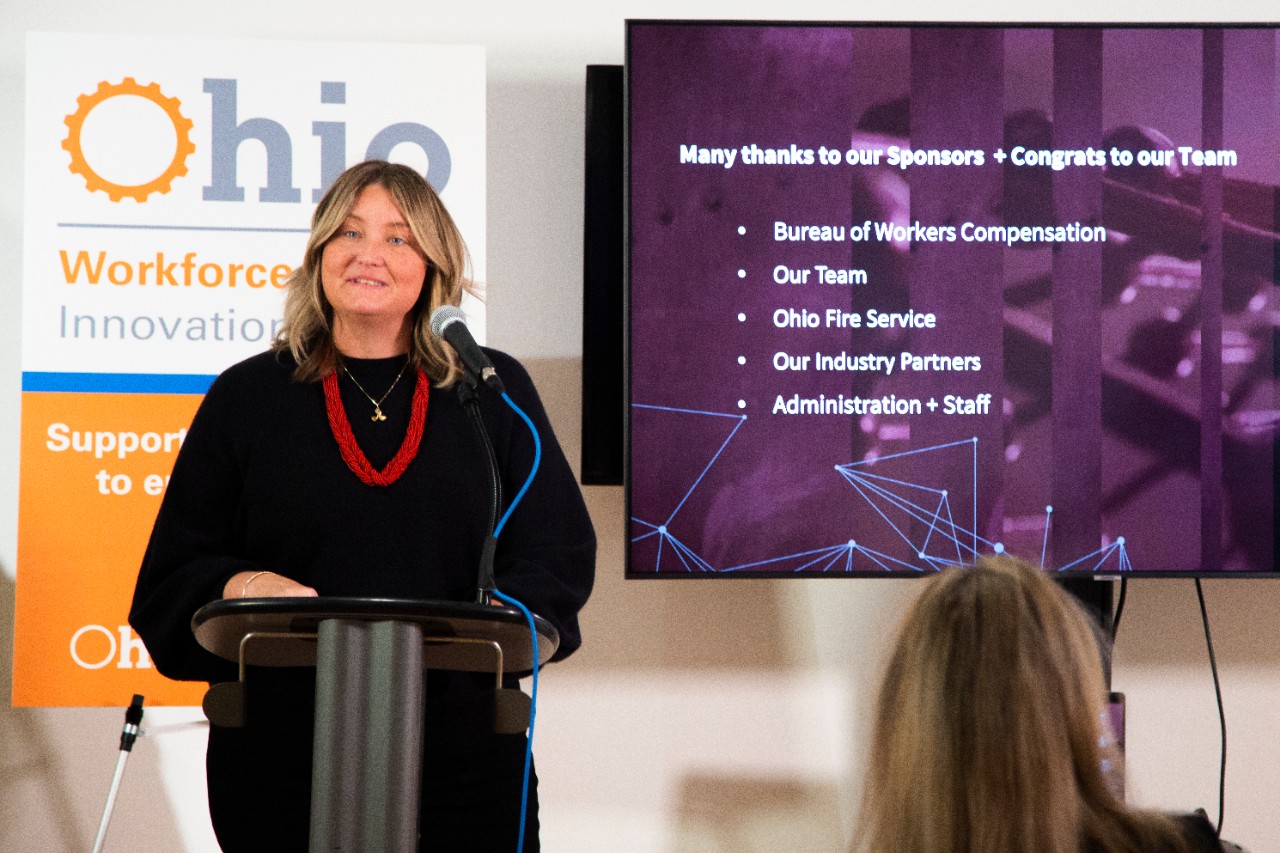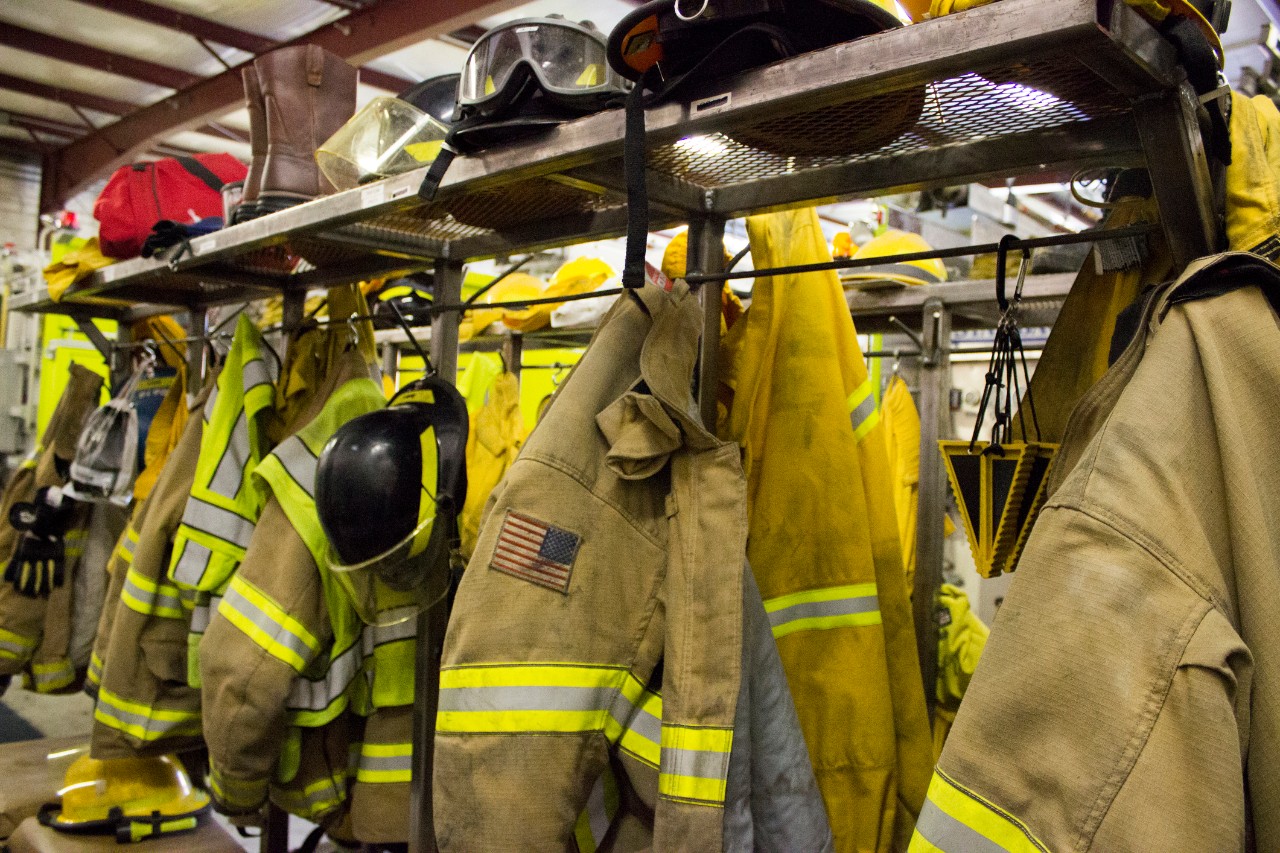
State grant allows for UC’s continued research on firefighter protective gear
Ohio Bureau of Workers Compensation awards researchers here over $2.5 million
A team of UC researchers across three colleges has been awarded an additional $1.5 million state grant to continue research on improving firefighter protective gear.
In 2022, the Ohio Bureau of Workers’ Compensation (BWC) awarded a UC team an initial $1.2 million to provide proof of concept on the development of a firefighter jacket liner that brings a firefighter’s body temperature down through advanced cooling technology and protects the body from other external hazards.

Current firefighter coats hang in the ready. Photo/iStockphoto/eyphoto.
State grant to research and develop
That grant, and the new $1.5 million grant to carry the proof of concept to commercialization, comes from a BWC Workforce Safety Innovation Center initiative for the benefit of workers employed in various fields including first responders, manufacturing, agriculture and other sectors requiring additional protection while on the job.
The project, led by Ashley Kubley, associate professor of fashion design in UC’s College of Design, Architecture, Art, and Planning (DAAP), includes 20-plus researchers from DAAP and UC’s College of Engineering and Applied Science (CEAS) and College of Medicine.

Research team leader Ashley Kubley, an associate professor of fashion design in UC’s College of Design, Architecture, Art, and Planning (DAAP). Photo provided by DAAP.
"Today's research is different — as we move into designing a more connected, integrated world of products and systems — we need teams of experts with different expertise, skills and perspectives to solve these interdisciplinary problems,” says Kubley.
Between 2022-23, the team designed, developed and user-tested their prototype and established its effectiveness for moderating the core body temperatures in firefighters during service by providing on-demand cooling inside their turnout coat. Preliminary findings show that the new garment outperformed the current industry standard turnout coats along several measures and was effective at reducing firefighter exposure to harmful heat stress and environmental contaminants.
The team is excited to be involved in helping to better protect Ohio firefighters who put their life on the line for us each day.
Ashley Kubley Associate professor of fashion design
The concept
According to Kubley, the team was able to effectively redesign the thermal and moisture management fabrics that are used in current turnout gear, making them thinner, lighter and more able to spread heat and wick moisture. A miniaturized wearable cooling system works in tandem with a patented carbon nanotube fabric system to create a cooled microclimate.
The system also provides new shielding, strength and protective features that have not been available in fire-compliant textile materials for personal protective equipment before. These innovations were developed by the design and engineering teams at UC using resources in the Nanoworld Laboratory in CEAS, the Fashion Technology Center and Rapid Prototyping Center at DAAP, among others.
“No other type of cooling system of this kind exists for firefighters due to the high barrier for entry into the market. The team is excited to be involved in helping to better protect Ohio firefighters who put their life on the line for us each day,” says Kubley.

Personal protective gear in a fire station . Photo/iStockphoto/Fred Mastison
Research partners
The team partnered with the National Institute for Occupational Safety and Health National Personal Protective Technology Laboratory in Pittsburgh, Pennsylvania, to run simulation tests using a thermal, sweating mannequin to validate the system prior to human testing.
They also partnered with LION Protects, a manufacturer of personal protection equipment in Dayton, Ohio, to test the new materials for compliance with national fire protection agency standards and also to manufacture the fire coat samples in their production facilities.
The team then recruited and tested the design with firefighters from departments around the Cincinnati area. Firefighters participated in ergonomic lab testing in the Biomechanics and Ergonomics Research Laboratory at UC and in live burn training at the Great Oaks Career Campus in Sharonville, Ohio.
Using sensors, the researchers measured heat flux, core body temperature and heart rate during activity which allowed the team to evaluate the firefighters' body response to the intervention and environment in real time. Through focus groups, observation and assessment sessions, they employed user feedback to improve the design and functionality of the intervention for better usability and operation, comfort and protection and safety.
Featured image at top iStockphoto/Grandfailure
Impact Lives Here
The University of Cincinnati is leading public urban universities into a new era of innovation and impact. Our faculty, staff and students are saving lives, changing outcomes and bending the future in our city's direction. Next Lives Here.
Related Stories
New climate change health research center under development at UC
October 15, 2024
The National Institute of Environmental Health Sciences of the National Institutes of Health has awarded a grant to the University of Cincinnati to establish the Cincinnati Center for Climate and Health.
UC institute picks four industry research projects for 2024
March 7, 2024
A University of Cincinnati institute selected four new projects to tackle in its second year of helping high-tech industries address their most complicated problems. UC’s Industry 4.0/5.0 Institute is dedicated to harnessing UC’s collective talent across campuses to help solve pressing issues facing businesses.
UC reaches $740M in research expenditures
January 30, 2025
The University of Cincinnati and its affiliates reached $740 million in research expenditures in 2024, a 6% increase over the previous year and a record for UC. Research partners include UC Health, Cincinnati Children’s, the Cincinnati VA and the University of Cincinnati Research Institute.
